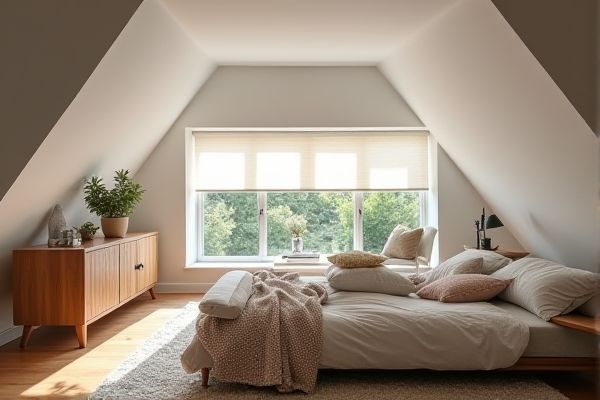
Attic blackout blinds provide complete darkness, ideal for bedrooms or media rooms where light control is crucial, while light filtering blinds gently diffuse sunlight, creating a bright yet soft ambiance perfect for living spaces. Discover which option best suits Your attic to enhance comfort and functionality by exploring the full article.
Table of Comparison
| Feature | Attic Blackout Blinds | Light Filtering Blinds |
|---|---|---|
| Light Control | 100% Block Out Light | Allows Soft, Diffused Light |
| Privacy | Maximum Privacy | Moderate Privacy |
| Energy Efficiency | High Insulation, Reduces Heat & Cold | Moderate Insulation |
| Material | Opaque, Thick Fabrics or Vinyl | Sheer or Semi-opaque Fabrics |
| Best Use | Bedrooms, Media Rooms, Attics | Living Spaces, Kitchens, Offices |
| Cost | Usually Higher | Usually Lower |
| Installation Areas | Ideal for Sloped Attic Windows | Fits Standard & Sloped Windows |
Introduction to Attic Window Treatments
Attic window treatments vary primarily between blackout blinds and light filtering blinds, each designed to control natural light and thermal insulation differently. Blackout blinds provide complete darkness and superior UV protection, making them ideal for bedrooms, media rooms, and spaces requiring maximum privacy and light control. Light filtering blinds allow soft, diffused light to enter while reducing glare and heat, enhancing ambient lighting and maintaining a comfortable attic environment.
What Are Blackout Blinds?
Blackout blinds are specially designed window coverings that block nearly 100% of external light, making them ideal for attics where controlling sunlight is crucial. These blinds feature dense, opaque materials that prevent light penetration, providing enhanced privacy and improved insulation. Choosing blackout blinds for your attic ensures complete darkness, perfect for rooms used as bedrooms, media spaces, or home offices requiring minimal light interference.
What Are Light Filtering Blinds?
Light filtering blinds are designed to soften and diffuse natural sunlight while maintaining privacy, making them ideal for attics where controlled light is essential. Unlike blackout blinds that block out nearly all light, light filtering blinds allow a gentle glow to illuminate your space without harsh glare. Your choice between these blinds depends on the balance you want between light control and ambient brightness.
Key Differences Between Blackout and Light Filtering Blinds
Blackout blinds provide complete darkness by blocking 100% of incoming light, making them ideal for bedrooms and media rooms where light control and privacy are crucial. Light filtering blinds allow natural light to softly diffuse into the room while reducing glare and UV rays, making them suitable for living spaces that benefit from brightness without harsh sunlight. The primary differences lie in their fabric opacity and purpose: blackout blinds use opaque materials for total light blockage, whereas light filtering blinds employ semi-transparent fabrics to maintain a balance between light and privacy.
Benefits of Attic Blackout Blinds
Attic blackout blinds offer superior light-blocking capabilities, making them ideal for creating a dark, cozy environment that enhances sleep quality and energy efficiency. These blinds also provide excellent insulation, helping to reduce heat loss in winter and prevent heat gain in summer, lowering your energy bills. You benefit from increased privacy and protection against harmful UV rays, preserving attic furnishings and overall home comfort.
Pros and Cons of Light Filtering Blinds in Attics
Light filtering blinds in attics softly diffuse sunlight, creating a pleasant glow while maintaining privacy and reducing glare, which helps protect your furniture and flooring from UV damage. However, these blinds do not block out light completely, making them less ideal for those seeking total darkness for sleep or media rooms. Your choice depends on whether you prioritize ambiance and natural light management or need full light control.
Energy Efficiency Comparison
Attic blackout blinds provide superior energy efficiency by blocking nearly 100% of sunlight, reducing heat gain during summer and heat loss in winter, which lowers HVAC costs significantly. Light filtering blinds allow some natural light to pass through, offering moderate insulation but less effective temperature control. Choosing blackout blinds maximizes thermal regulation, leading to enhanced energy savings in attic spaces.
Privacy and Light Control Considerations
Attic blackout blinds provide superior privacy by completely blocking external light, making them ideal for bedrooms or media rooms where darkness and privacy are essential. Light filtering blinds allow some natural light to enter while maintaining moderate privacy, suitable for living spaces where a soft glow is preferred without full exposure. Your choice depends on whether you prioritize total darkness and privacy or a balance of light control with ambient illumination.
Installation and Maintenance Tips
Attic blackout blinds require precise installation to ensure complete light blockage, typically involving tightly sealed edges and custom measurements to fit skylights or irregular window shapes. Maintenance involves regular dusting and occasional fabric cleaning with a mild detergent to preserve their light-blocking properties and prevent fabric degradation. Light filtering blinds offer easier installation with standard fittings and need gentle cleaning to maintain their translucency without damaging the delicate filters, making them a low-maintenance option for your attic.
Choosing the Best Blinds for Your Attic
When choosing the best blinds for your attic, consider attic blackout blinds for complete darkness and optimal insulation, ideal for bedrooms or media rooms. Light filtering blinds allow natural light while reducing glare, perfect for daytime use and spaces needing some brightness without direct sunlight. Your choice depends on whether you prioritize total light control or a softer, diffused glow to enhance attic comfort.
 homyna.com
homyna.com